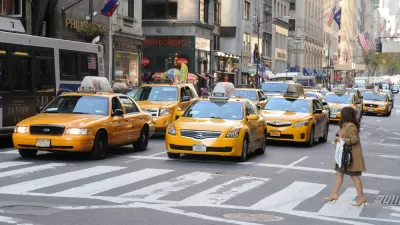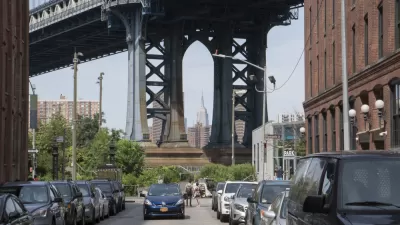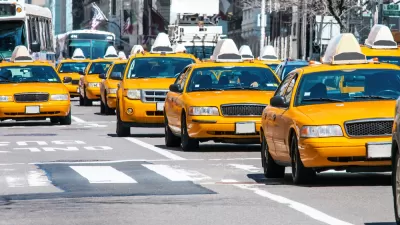Stakeholders are hoping that the 93 million car-for-hire trip records will better inform a heated debate in NYC.

There are many questions about the effects that the app-based car service company Uber is having in New York City. Among them: Is Uber expanding the market, or would Uber users otherwise hail taxis? Are Uber drivers causing more traffic congestion in the city’s core business district?
Thanks to the release of a lot of data from both Uber and the city’s Taxi and Limousine Commission (TLC), reporters at FiveThirtyEight have begun to make sense out of the controversial claims made by the various stakeholders. Carl Bialik, Andrew Flowers, Reuben Fischer-Baum and Dhrumil Mehta analyzed 93 million records of Uber and TLC taxi rides taken over a six-month period in 2014. The data include date, time, and pickup coordinates.
While there are not yet many conclusive answers, Bialik et. al. have revealed some important facts. "While we can’t yet say whether Uber has exacerbated Manhattan congestion, the data we’ve analyzed shows that Uber has a point when it claims that it is doing a better job than taxis in serving the boroughs of New York City outside of Manhattan." During April to September of last year, 22 percent of Uber rides originated outside of Manhattan, compared with 14 percent for yellow and green taxis (green taxis are only allowed to pick up rides outside of the Manhattan core).
"The city, though, has a point when it says that most of Uber’s trips are in the city’s busiest areas." In fact, the share of Uber pickups in the core business district is nearly identical to conventional taxi pickups, 63 percent and 62 percent, respectively.
The FiveThirtyEight team promises more insights to come. "[We’ll be] looking at whether Uber serves predominantly black neighborhoods or low-income neighborhoods better than cabs do, for instance."
FULL STORY: Uber Is Serving New York’s Outer Boroughs More Than Taxis Are

Alabama: Trump Terminates Settlements for Black Communities Harmed By Raw Sewage
Trump deemed the landmark civil rights agreement “illegal DEI and environmental justice policy.”

Study: Maui’s Plan to Convert Vacation Rentals to Long-Term Housing Could Cause Nearly $1 Billion Economic Loss
The plan would reduce visitor accommodation by 25% resulting in 1,900 jobs lost.

Why Should We Subsidize Public Transportation?
Many public transit agencies face financial stress due to rising costs, declining fare revenue, and declining subsidies. Transit advocates must provide a strong business case for increasing public transit funding.

Wind Energy on the Rise Despite Federal Policy Reversal
The Trump administration is revoking federal support for renewable energy, but demand for new projects continues unabated.

Passengers Flock to Caltrain After Electrification
The new electric trains are running faster and more reliably, leading to strong ridership growth on the Bay Area rail system.

Texas Churches Rally Behind ‘Yes in God’s Back Yard’ Legislation
Religious leaders want the state to reduce zoning regulations to streamline leasing church-owned land to housing developers.
Urban Design for Planners 1: Software Tools
This six-course series explores essential urban design concepts using open source software and equips planners with the tools they need to participate fully in the urban design process.
Planning for Universal Design
Learn the tools for implementing Universal Design in planning regulations.
Caltrans
Smith Gee Studio
Institute for Housing and Urban Development Studies (IHS)
City of Grandview
Harvard GSD Executive Education
Toledo-Lucas County Plan Commissions
Salt Lake City
NYU Wagner Graduate School of Public Service





























